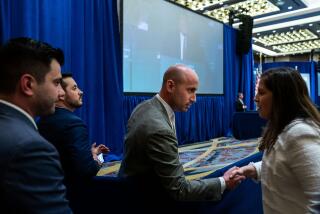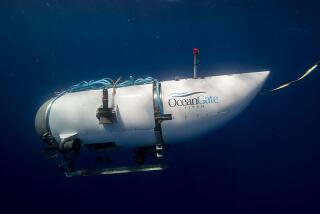Going Out on a Limb
- Share via
Highlighting the importance of innovation to his research-oriented company, Eli Lilly Chief Executive Randall Tobias surprised 200 high-level employees at a global conference in 1995 by giving out awards for “best failure” and “thoughtful risk-taking.”
In an American business culture where failure is generally punished and risk often discouraged, Tobias was among the first of a growing number of managers who are asking their employees to take more calculated risks for the long-term good of the firm.
Overcoming years of conservatism won’t be easy.
Many corporations, particularly public ones, are constantly striving to balance risk with analysts’ expectations and fiduciary responsibility to shareholders, and managers generally will err on the side of caution.
“Sometimes they become so enamored with being the best that they stop taking risks so they won’t make any mistakes,” said Randall P. White, co-author of “The Future of Leadership: Riding the Corporate Rapids Into the 21st Century” (Pitman Publishing). “But when they don’t make mistakes, they don’t learn anything new.”
Whether risk-taking is encouraged by executives depends largely on the industry, the firm’s location and its employees. Technology firms, apparel companies and biotech concerns take risks often to adapt to the fast pace common to those fields. Other industries, such as banking, aerospace and auto making, have historically been slow to accept risk as a means to advance their businesses.
Experts agree, however, that all companies should institutionalize risk to foster the creativity necessary to compete in a fast-paced global economy.
“Companies need to reinforce people for taking risks and not stifle them with restrictions,” said Richard Hagberg, chief executive of Hagberg Consulting Group in San Francisco. “There’s more interest now than ever before in changing corporate culture to make it more flexible and adaptable.”
Many corporations discourage risk-taking by discouraging employees from openly expressing their views, by centralizing control over decisions and by demanding that workers conform to a rigid set of expectations.
Fear of failure and its possible short-term impact on company performance also causes executives to punish employees for challenging the status quo.
“Fear and risk are inextricably linked,” White writes. “If the pressure to perform is on, it can require strong nerves to weather that initial dip in performance” that change might bring.
Workers also tend to compartmentalize their lives into how they act at work and how they act during their off hours.
“You’ll walk into a manager’s office and see them in their Brooks Brothers suit and then you’ll see a tiny picture in the corner of them skydiving,” said Doug Hall, co-author with David Wecker of “The Maverick Mindset: Finding the Courage to Journey from Fear to Freedom” (Simon & Schuster). “They do time at work but really live life through their hobbies.”
Hall, whom Inc. magazine dubbed “America’s top new-product idea man” in its May issue, quit a marketing job at Procter & Gamble in 1991 to found Richard Saunders International, a product-development and idea-generating company based in Cleveland.
The company charges firms such as Walt Disney Co., Nike Inc., PepsiCo Inc. and AT&T; Corp. about $150,000 a session to brainstorm new product ideas at company headquarters, also known as Eureka Mansion.
Hall said studies commissioned by his firm show that if employees are encouraged to apply on the job the adventurous spirits they indulge in their off hours, innovations will soon follow.
“We did an analysis of 300 people and measured their creativity by giving them a set amount of time to invent ideas,” Hall said. “We found those who regarded themselves as having an adventurous spirit created, on average, more quality ideas.”
In fact, experts say, promoting learning and innovation at work lessens the failure rate a corporation experiences when it’s striving to compete in today’s global economy.
“Those who make continuous innovation a part of their firm’s culture are using adventure to minimize risk,” said Tom Kaplan, a research fellow at the Family Enterprise Center at Kennesaw State University in Georgia.
To encourage risk-taking, executives should flatten hierarchies and clarify the work habits the organization values. They also need to loosen up a little, give up some control and have some fun, Hagberg said. Many entrepreneurs, like Hall, quit their corporate jobs to start their own firms in an effort to put adventure into their work lives.
“It’s no accident that small entrepreneurial firms have created the vast majority of new jobs in recent years,” Kaplan said.
Those left behind sometimes try to shed corporate cowardice by taking employees on adventure trips outside the office. Indeed, the adventure travel industry is booming, boosted in part by corporate dollars. Adventure provider Outward Bound is receiving more requests to create trips for entire divisions, rather than the executive excursions that until recently characterized the 56-year-old, Garrison, N.Y.-based business.
Consultants caution that while the team-building lessons offered by adventure travel firms can be invaluable learning experiences, they are not a panacea for years of discouraged creativity.
Group adventures often challenge and bond employees, Hagberg said. “But research shows if you don’t follow up, the trust and awareness that emerged from these trips are not sustained--and the key to change is sustainability.”
More to Read
Inside the business of entertainment
The Wide Shot brings you news, analysis and insights on everything from streaming wars to production — and what it all means for the future.
You may occasionally receive promotional content from the Los Angeles Times.










